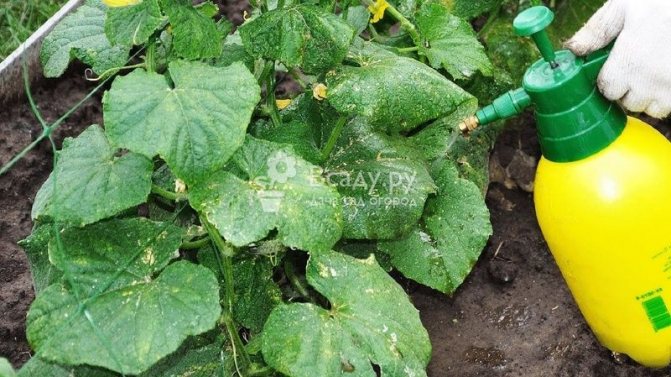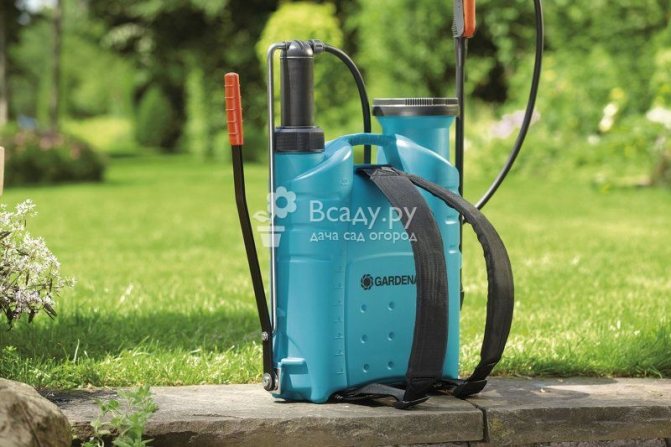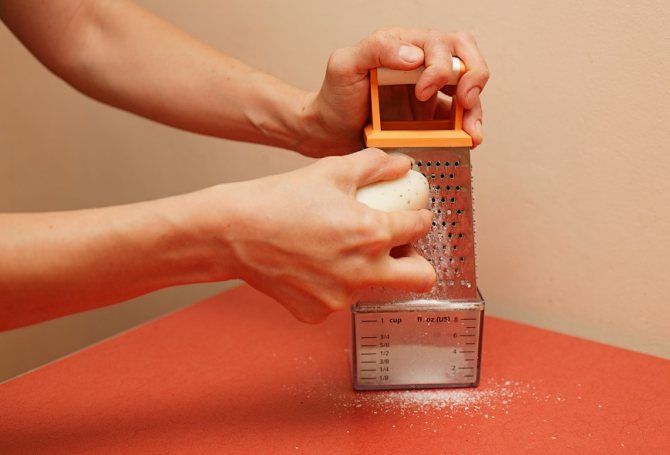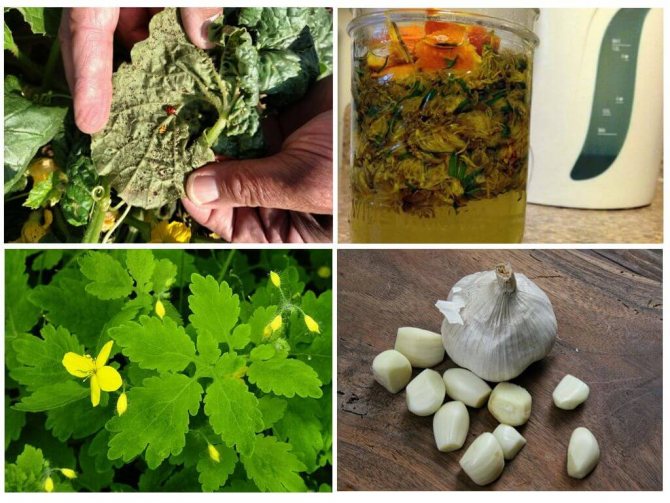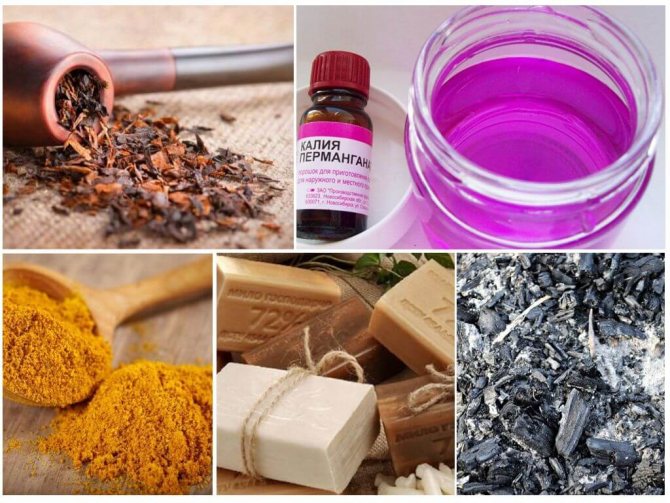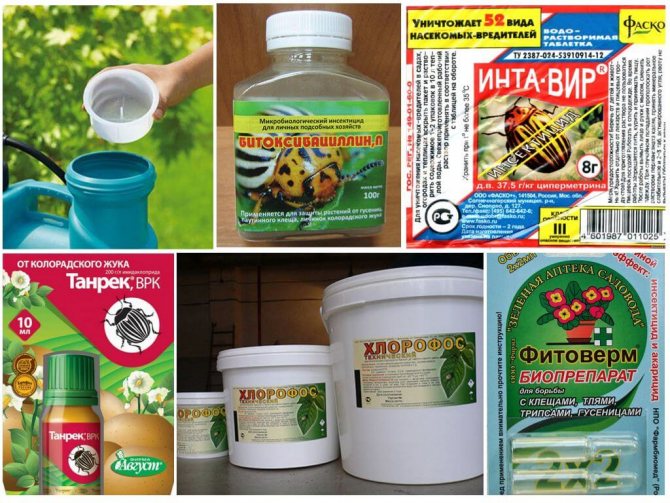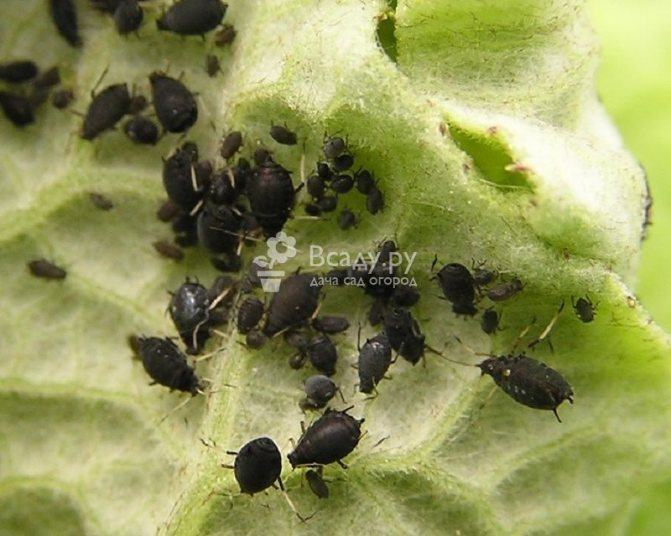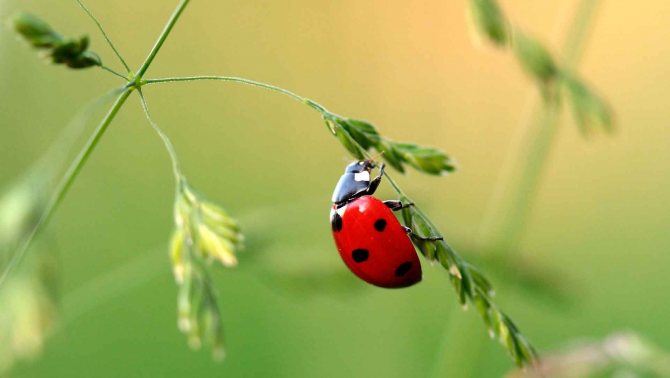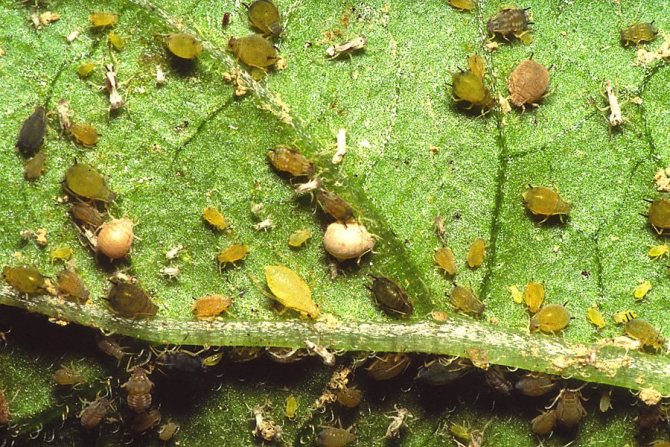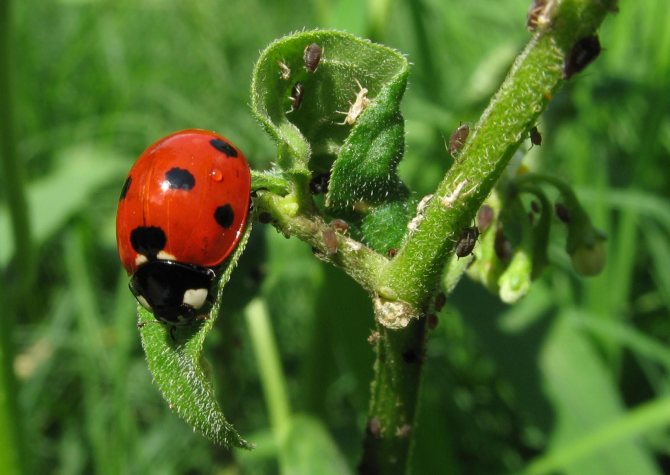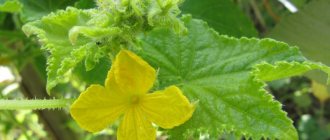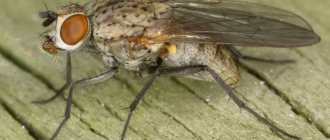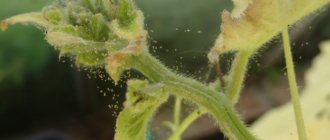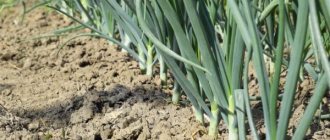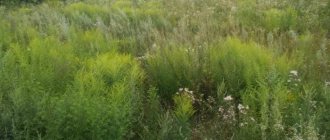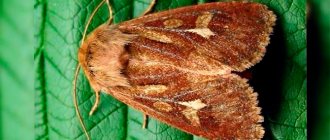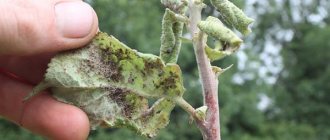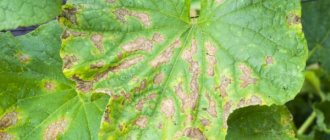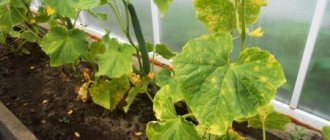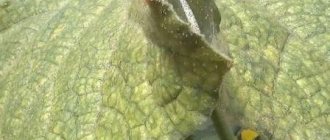The melon aphid often annoys gardeners. It affects cucumbers, pumpkins and zucchini in the greenhouse and in the open field, inhibits their growth and significantly reduces the yield. It is important to start the fight against aphids immediately after detection, as well as timely prevent the appearance of the pest. Ways to effectively get rid of aphids on cucumbers in a greenhouse are described in this article.
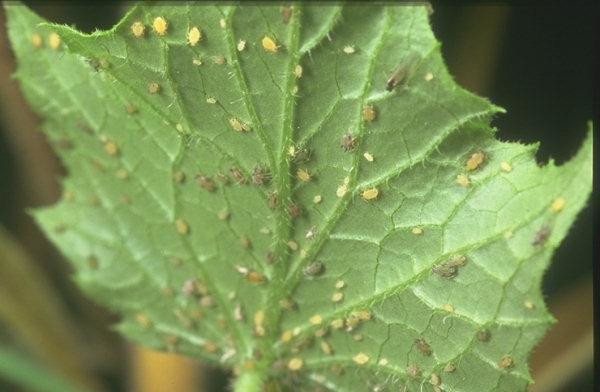
Aphids on cucumbers in a greenhouse how to fight
Aphids on cucumbers
As already mentioned, aphid colonies are capable of settling and feeding on virtually all plant species. There is a melon variety, the diet of which is based on cucumber seedlings, as well as zucchini.
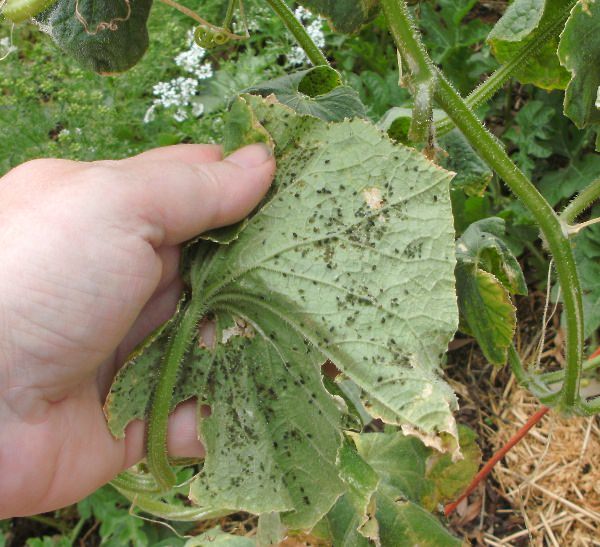

This is an independent subspecies that can be distinguished from other types of aphids by the following characteristic features:
- Body length varies from 1.2 to 1.9 mm.
- Green color of any shades: from lightest to darkest color. Some individuals have black bodies.
- There are insects with wings. Usually this happens with a strong population growth, then the pests begin to lack space and they are forced to fly to the nearest places with food suitable for them.
- In most cases, they try to stick to the lower surface of foliage or fruits, so as not to expose themselves once again to the threat that many other insects pose to them.
- In cold winter months, they can be found in greenhouses or other places where they stick to weeds due to the lack of familiar food. After warming up the air to at least + 5 ° C, they begin to show activity and multiply rapidly, increasing the colony.
The main evidence that cucumbers are susceptible to attack by melon aphids are the following:
- Withering of plants, gradually yellowing and drying of foliage.
- Drying and early fall of inflorescences.
- Detection of pest colonies by visual means.
This variety feeds not only on cucumber inflorescences and foliage, but also on the vegetables themselves, so the colony usually covers the entire plant as a whole.
Description of the pest
There are many types of aphids in nature. A melon variety of an insect can damage cucumbers. Ants are the distributors. They transfer aphids from one plant to another.
The size of the aphid is small, the body is not more than 2.2 mm. The color is different: white, black-green, green-yellow, brown. The pest overwinters on plant debris. Withstands frosts down to -16 degrees.
In the greenhouse, aphids can be found already in the spring, in open beds a little later - at the end of June. Insects develop rapidly. In 10 days, the larva turns into an adult. Therefore, you need to save the plants as soon as the first signs appear on the leaves.
Insects are located on the inside of the leaf and feed on the seedling sap. Light yellow spots begin to appear on the leaf plate, a sticky, whitish film is noticeable. Gradually, the leaves curl, dry up, the ovaries fall off. The plant begins to look weak, wilted.
In addition, aphids become the cause of the spread of dangerous viral infections.
Ways to combat aphids
To date, there are a large number of various methods of combating aphids, below will be considered the most effective options with different principles of action.
Insecticides
The use of various insecticidal preparations is one of the most effective and quickest ways to get rid of these insects.
This technique has the following advantages:
- A guaranteed result with the right choice of means.
- High speed of action of most drugs.
- Destruction of not only aphids, but also a number of other pests.
- Creates a protective effect that prevents reappearance.
At the same time, the negative side of this method is only one - the toxic effects of many insecticides affect not only pests, but also the plants and soil themselves.
For this reason, you will have to wait a certain amount of time before you can start harvesting. It is important and correct to choose the right drug so that it has an effect on aphids.
For this reason, it is recommended to pay attention to insecticides, which include the following substances:
- Karbofos is the most famous ingredient in many insect repellents. It consistently shows good results, and its other advantage is its versatility, which allows it to destroy all types of pests.
- Fufanon according to the principle of action, it is similar to karbofos, it has a toxic effect with simple contact with the substance, after which the insect also infects its relatives.
- Akarin and Bankol are analogs that have a combined effect, poisoning aphids on any contact or ingestion. They affect the central nervous system, causing serious malfunctions in it, which leads to paralysis and subsequent death, since pests will not be able to perform elementary actions to maintain their vital activity.
If you single out specific chemicals that can be purchased in stores, then Tanrek, Aktara or Biotlin show good results. Moreover, they cannot be used not only before harvesting, but also during the setting of future fruits.
Chemical biological products
This type of remedy has both positive and negative properties.
The following features can be distinguished, which are at the same time the main differences from insecticidal preparations:
- Delayed action, aphids must be destroyed, but it won't be instantaneous.
- Higher level of safety, since the principle of operation does not imply chemical poisoning. For this reason, biological agents are often used shortly before harvest or during fruit setting. However, it is recommended that at least five days elapse between processing and collection.
Today there is a wide range of such funds, below are examples of those options that have managed to prove themselves from the most positive side:
- Fitoverm released in liquid form, the aphid begins to die two days after treatment, and after a week the colony usually disappears completely.
- Entobacterin it is recommended to use it only in warm conditions, for the drug to work, a stable temperature above + 20 ° C is required The complete destruction of the population occurs in 5-9 days, depending on weather conditions.
- The arrow is the most effective biological agent, since the visible effect will come just two days after the treatment.
Folk remedies
A large number of various folk remedies for combating aphids have survived to this day. They still have not lost their relevance, because they have passed the test of time, and are also much safer than most modern techniques.
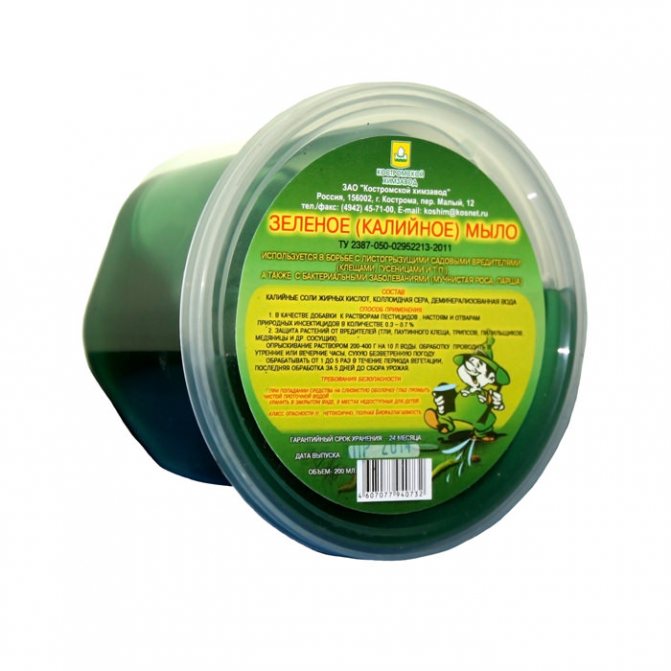

The following are examples of the most popular and effective remedies:
- Green potash soap is a very easy-to-use product that is enough to grate and dissolve in water. The resulting solution must be rubbed with plants affected by aphids. The only condition: soapy water should not get on the ground, so it is recommended to cover it with something that does not get wet.
- All types of aphids do not tolerate citrus fruits, what can be effectively used in the fight against them. This requires only about 200 grams. lemon, tangerine or orange peels, which are poured with water brought to a boil, and then left to stand for 3-4 days in any dark and cool place. The resulting liquid can be used to spray the affected plants with a spray bottle.
- A very simple technique was developed by people who smoke. It is enough to cover the affected plant with a bag and exhale cigarette smoke there. The bag must be tied so that it remains tight, it will be possible to remove it after 12 hours, all pests will be dead by that time.
- Onions are also a good helper in the fight against aphids. You will need to grate one onion and dilute the resulting gruel with a liter of water. The resulting infusion is settled for a day, after which it can be sprayed with a spray bottle. Among other things, this will be a good preventive measure against many other insect pests.
Rules for the use of aphid remedies
In order to effectively get rid of aphids while not harming the grown plants even more, it is necessary to adhere to the following rules for using special means:
- When using biological or chemical products, you must first carefully read the instructions that come with them. For funds with a different composition, the nuances of application may have fundamental differences.
- It is not allowed to exceed the permissible norms for the use of insecticides, since this will not increase their efficiency, but it can destroy the cultivated crops.
- When carrying out chemical processing, consume fruits from treated plants allowed no earlier than a month later to eliminate the risk of poisoning.
- When treating crops with insecticides, you need to remember about your own safety.: the procedure should be carried out with rubber gloves on hands, during its implementation it is not allowed to smoke or eat food, and it is also necessary to exclude the possibility of getting the substance on the skin, mucous membranes, in the respiratory or digestive system. After finishing the treatment, wash your hands in warm water and soap.
Prophylaxis
Sometimes it is much easier to take a set of measures that will help to avoid the appearance of these pests than to deal with them later.
To do this, it is recommended to adhere to the following tips for preventing the appearance of aphids:
- Before planting seedlings, carefully examine them and destroy insects immediately after detection. Otherwise, there is a risk of contamination of the still healthy plants in the neighborhood.
- Plant carrots, dill or parsley around the cucumber beds. They will quickly attract hoverfly wasps to this place, which are natural enemies of aphids.
- Sprinkle the paths between the beds with sawdust, as this will be a good environment for the settlement of earwigs - varieties of skin-winged insects, the basis of the diet of which is precisely aphids. This will lead to a rapid reduction of colonies or their complete destruction.
- Attract birds that feed on these pests. This can be done by building birdhouses or feeders, but it must be borne in mind that they can harm many other crops grown.
- Plant in the immediate vicinity of the cucumber beds of the plantthe smell of which aphids cannot stand, such as thyme or lavender.
- Timely removal of weeds from the beds.
Chemical biological products
- "Bitoxibacillin";
- Fitoverm;
- Aktofit.
Important! Drugs in this category are harmless to humans. Within a couple of days after spraying, cucumbers can be safely used for food.
Foliar fertilizing with phosphorus-potassium fertilizers will also help to overcome aphids on cucumbers. They are applied once every 7 days until the insects are completely destroyed. The solution used can be easily prepared by yourself: 20 g of superphosphate + 10 g of potassium chloride + 10 water.
A source
Aphid damage
The harm that aphids cause by their presence is undeniable. In most cases, it is as follows:
- Destruction of leaves and young fruits, sometimes irreparable harm is caused to plants, which leads to their death.
- Spreading a large variety of infectionsthat can be deadly for cultivated plants and crops, and not only for cucumbers.
- Large colonies attract the attention of insects, and not only those that feed on aphids. For example, ants live in symbiosis with these pests, and the neighborhood with them has not only positive aspects, but also a large number of various disadvantages.
The reasons
The main cause of planting infection is ants. They are attracted by the sweet honeydew on the leaves. Crawling from place to place, insects carry the larvae, infecting new bushes.
Violation of agricultural practices, thickening of plantings, lack of fresh air in the greenhouse, excessive nitrogen content in the soil contribute to the appearance of a pest on the site.
Aphids live in dry weeds and uncleaned plant debris since last season. At air temperatures above +5 ° C, females move to young plantings and begin to lay eggs on the back of the leaves.
Tips & Tricks
Summing up, you can give the following tips and tricks from experienced gardeners that relate to issues of aphid control:
- When weeding beds, do not postpone weeding until later., since their storage near cultivated plants also creates good conditions for the habitation of these pests.
- When fighting aphids, it is recommended to destroy all anthills at the same time. and get rid of their inhabitants, as they often protect these pests and hide them in their homes.
- For chemical destruction, the combined use of insecticides is recommendedthat have contact, intestinal and other methods of influence. This increases the chances of poisoning most of the individuals in the colony and the spread of a global epidemic.
- When carrying out the procedure for processing cucumber seedlings with toxic substances, it is necessary to remember about the safety of children and pets, avoiding their contact with these plants.
Breeding features
White or black aphids on cucumbers are insects that do not exceed 6 mm in length. It adapts to all climatic conditions. It hibernates in the state of eggs and it is during this period that the most effective fight against it is in vegetable farms. Asexual uterus (parthenogenesis) is responsible for the continuation of the genus. When the time comes, the "virgin" female crawls out of the egg. Its distinctive feature is its wingless structure, although in some individuals they can still grow. Males appear in the population towards the end of summer. Males and females mate, the latter lay eggs, after which the entire sexual generation dies off.

